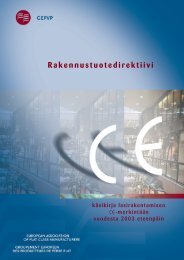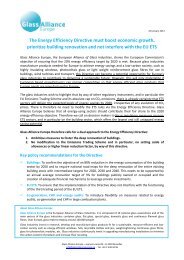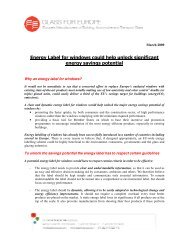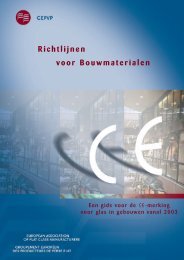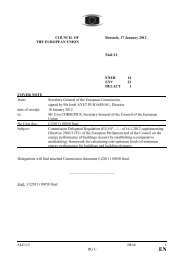EN 1096-4 - Glass for Europe
EN 1096-4 - Glass for Europe
EN 1096-4 - Glass for Europe
Create successful ePaper yourself
Turn your PDF publications into a flip-book with our unique Google optimized e-Paper software.
Evaluation of con<strong>for</strong>mity of<br />
“Coated glass” to hE N <strong>1096</strong>-4<br />
B.2.2<br />
Measurements<br />
The method of measurement is given in 7.2.<br />
Five test specimens are to be used <strong>for</strong> each<br />
characteristic determination. The evaluation<br />
of the characteristic concerns the five<br />
measurements.<br />
B.3 In<strong>for</strong>mation on ensuring durability con<strong>for</strong>mity<br />
Con<strong>for</strong>mity of the durability of the coating of<br />
a produced coated glass with the declaration<br />
classification, i.e. class A, B, S, C or D coating,<br />
will be ensured as long as the coating con<strong>for</strong>ms<br />
to the product subjected to the initial type<br />
test. The coating should con<strong>for</strong>m to its product<br />
description.<br />
The check on continuing con<strong>for</strong>mity during<br />
production will be by tests that can be either:<br />
- the initial type test on durability <strong>for</strong> verifying the<br />
declared class of coating, all in accordance to<br />
<strong>EN</strong> <strong>1096</strong>-2 or <strong>EN</strong> <strong>1096</strong>-3; or<br />
- proxy testing.<br />
Proxy tests are developed by manufacturers<br />
themselves on the basis of experience collected<br />
from the feed back circuit from measuring<br />
deviations to re-adjustment of the process<br />
conditions. Those tests and the related optimal<br />
frequencies gained from the same experiences<br />
depend on the type of coating and are the<br />
property of the manufacturer.<br />
Proxy tests can also be standardized tests where<br />
the material or the requirements (frequency,<br />
numbers of cycles, etc.) are changed.<br />
Such tests can be <strong>for</strong> instance:<br />
a) A, B and S coatings:<br />
- ISO 3537, <strong>for</strong> abrasion resistance test<br />
- ASTM D1044-99, <strong>for</strong> the Taber test<br />
- ASTM C724-91, <strong>for</strong> acid resistance (HCl) test<br />
b) C and D coatings:<br />
- ASTM D903-98, <strong>for</strong> peel or stripping testing<br />
- ASTM B571-97, <strong>for</strong> adhesive testing<br />
- Leybold-Heraeus: Doc 14-S13.02, <strong>for</strong><br />
electrical resistance measurement method<br />
The list of proxy tests mentioned is not<br />
exhaustive. The examples given have been<br />
found to work and are quicker than the initial<br />
type tests and as such are more applicable to<br />
factory production control.<br />
The manufacturer will need to select the<br />
test(s) that are appropriate <strong>for</strong> their coating<br />
type.<br />
See Bibliography <strong>for</strong> more detail of the<br />
specific tests.<br />
19



